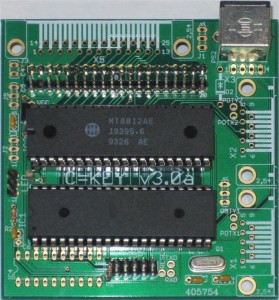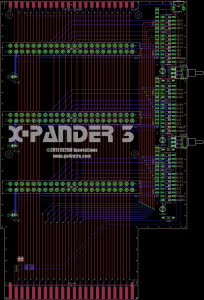RETRO Innovations is now represented on Google+. We’ll try to keep it updated as often as possible. Add us to your “Preferred Stores” Circle! 🙂
Blog
Spring-Time Retro-Computing Convention
Though the Cincinatti Commodore Computer Club (C4) EXPO will not be held in 2012, Payton Byrd is planning the Spring-Time Retro-Computing Convention in Clarksville, TN the weekend of May 25-27, 2012. The event will be held at the Riverview Inn and will run 48 continuously for 48 hours. As evidenced by the name, it appears like all classic machines will be represented/welcome.
As with NOTACON, we’d love to hear from readers who would enjoy a meet and greet. Tennessee is quite a journey from the store, but it’s doable.
NOTACON
Far from being boring, the classic computing events calendar is already filling up! NOTACON will be held in Cleveland, OH on April 12-15, 2012. If you’re not aware, this event is short for “Not a Conference”, and its goals are to showcase technologies, philosophies, and creativity not often given a focus at other conferences. The conference also sports its own demoparty: PixelJam.
RETRO Innovations is considering attendance, and we’d love to hear from others who would enjoy meeting us while there. They don’t offer sales tables, like at other conferences and conventions, but we could show off development, PCB design, or something else of interest. If we do come, we’ll unofficially bring some stock for those who want to pick up the latest offerings.
Early registration closes on Feb 17th (extended one week from the original February 10th). If you’re considering attendance, it’s $25.00 cheaper to register now!
uIEC in Action
Sean Ober sends us this nice YouTube clip showing off his uIEC C64C internal installation. Thanks to Sean, and others who record their installations and uses. We welcome links to multimedia via our contact form. Please let us know who created the content so we attribute correctly!
uIEC_Man (GEOS Image Manager)
Werner Weicht has released uIEC_Man, a GEOS utility that supports mounting and unmounting different disk images while in GEOS. The utility works with GEOS, Wheels, and Megapatch V3. As Werner notes, users are highly encouraged to read the included manual before starting the utility.
sd2iec 0.10.2 Now Available
Ingo Korb has recently released version 0.10.2 of sd2iec, which is the firmware that powers devices like the uIEC. A list of enhancements is noted below. Because the uIEC can auto-update itself, users need only download the ZIP archive, unpack the contents onto a partition 1 of their SD card, IDE HDD, or CF card, and reboot.
Changes in sd2iec 0.10.2:
- Correct end of generated raw directory information
- compiling with all fastloaders disabled should now work
- ULoad M3 auto-exits when ATN becomes active
- Improve code size (to free enough space for…)
- Support new fastloader: ELoad Version 1 (the one used by EasyProg)
C=Key now Shipping

By popular demand, we’re now offering both kit and assembled versions of our C=Key Commodore Keyboard Dual Mode Interface. This unit supports using a PS/2 keyboard to a VIC-20,C64,C64C,C128,C128D,C128DCR, or SX64 machine in one configuration. It can also interface keyboards for those same machines to a PS/2-based PC (or USB PC via a PS/2 to USB adapter). We’ve held off for years in offering this product, because PS/2 keyboards are getting scarce and we are redesigning the unit to work with USB keyboards. That said, numerous enthusiasts convinced us there is enough interest to offer the product in the store. Unlike our other offerings, we’re still considering this a “project” rather than a complete product offering. If you are a tinkerer who doesn’t mind getting his/her hands dirty with microcontrollers, this might be of interest. However, if you’re a fan of plug and play and easy upgrades, we encourage you to wait until a USB version is available.
EasyFlash 3 Introduction

In late 2010, a group of folks suggested the need for a KERNAL replacement cartridge. This cartridge would allow those with socketed KERNAL ROMs to enjoy KERNAL upgrades like JiffyDOS and would also help KERNAL developers try out new ideas before committing them to EPROM. Due to the complexity of “replacing” a ROM inside a machine without physically removing it, a Commodore Bounty was created to encourage someone to develop the solution. Thomas Giesel took up the challenge, finding a novel solution to the complexity, and developing an economically viable solution. Along the way, Thomas merged in some additional features, and the result is EasyFlash 3.
EasyFlash 3 offers a number of features:
- 8 8kB slots for alternative KERNAL ROM images,
- 7 EasyFlash I cartridge image slots.
- Support for the following cartridge formats
- Normal 8k
- Normal 16k
- Ultimax
- Ocean Type 1
- EasyFlash
- EasyFlash xbank
- USB support (for transfer of data to/from PC/Mac/Linux
- Field upgradeable firmware and hardware configuration
- Ability to replace/add/remove images from the C64
EasyFlash will soon be available from RETRO Innovations and can be used on the C64, C64C, and SX64. C128/C128D use is not currently supported.
One Designer’s Trash, Another’s Treasure

In hardware design, as with any endeavor, one strives to minimize errors. However, as with anything, some errors are more important to prevent or eliminate than others. When dealing with microcontroller-based projects, I concentrate on the printed circuit board and components. Software errors can be fixed after production, but once the hardware and PCB are produced, there are few opportunities for change.
Still, even with doublechecking the design and prototyping, an error crops up every so often. When that happens, I can’t bear to pitch the boards immediately, so I usually stuff them somewhere in the shop. You never know, they might have some use at some point.
I recently ran a tiny PCB with “gold immersion” plating, with black soldermask. Though it contained an error, the board proved visually striking. I showed them to my daughter, who enjoys pretty items, the smaller the better. She loves adding castoffs and “trash” items to her collection, and was understandably impressed by the “baby” circuit board. I told her she might find a use for them, at some point.
Less than a day later, she and her mother had determined the tiny PCBs might make unique jewelry items. After purchasing some earring hoops from a local shop, she and I created hoop earrings from the small circuit boards. We then created small storage cards for the jewelry, setting a price for the product, and dreaming up a name for her “business”. We informed her that once she meets expenses (the boards are free, since I’ve written them off as useless, but the hoops were purchased), the remaining sales income will be hers. I offered to promote them at the upcoming “World of Commodore” show and then list them in the online store for sale.
If you or someone you care for wants a unique single or set of earrings from “The Belle Rings”, look for them in the store shortly and enjoy!
X Pander-3 VIC Released to Production

The X Pander-3 VIC brings the ultimate in cartridge port expansion options to the Commodore VIC-20. The unit features 3 independently switched vertical ports and a companion horizontal port. Power, both I/O select lines, and all BLK and RAM select lines can be individually switched on or off, while the I/O select lines can be swapped on the second and third/fourth expansion slot. Units should be available for sale starting mid-January.